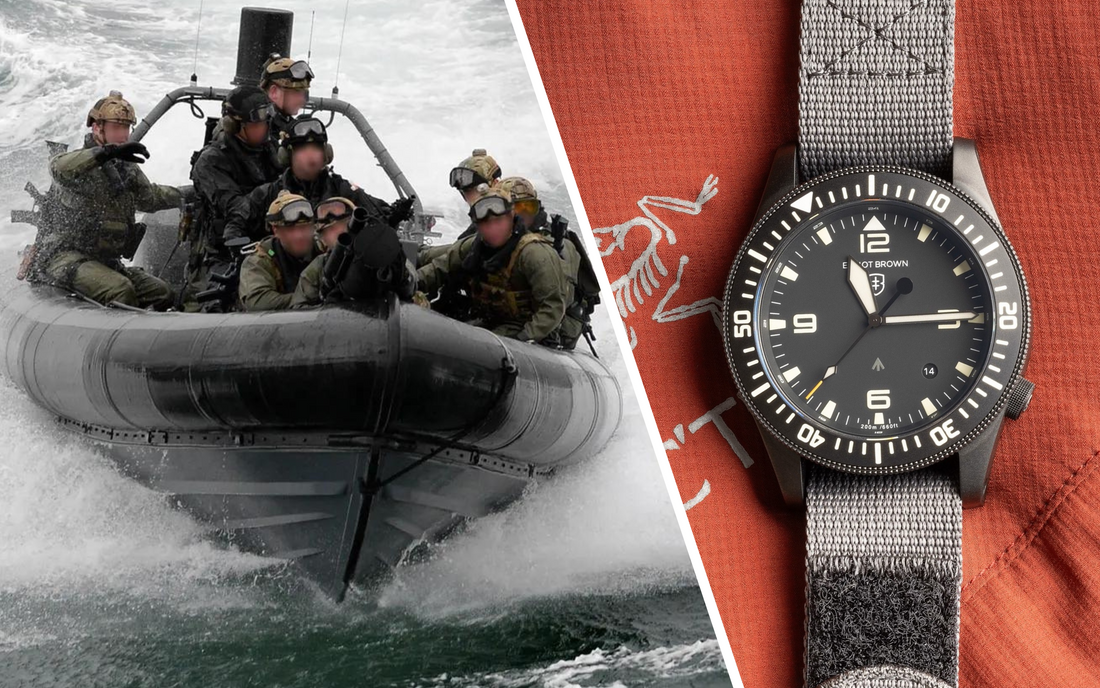How A British Independent Watch Brand Created The Latest SBS Issue Watch
The list of modern military-issued analog watches is short. The fact is, most forces have understandably transitioned to digital tool watches, arguably a more effective tool for modern warfare. That said, they do exist and one of the most interesting and least understood is the Elliot Brown Holton Professional. The Holton was designed from the ground up in partnership with and is currently issued to the British Special Boat Service (SBS), the United Kingdom’s “tier one” maritime special operations force unit, a loose equivalent to SEAL Team Six.
Many of the stories we tell revolve around “unit watches” or private purchases used during an individual operator's career. This is the story of a purpose-built tool watch designed to satisfy a specific operational requirement. But it is also the story of the SBS’s culture and the role watches play.

When newly badged operators arrive at Poole, the headquarters of the British Special Boat Service, they receive a green beret with the SBS insignia, a belt, a hardcover book on the history of their unit, and the standard-issue Elliot Brown Holton Professional. These are just things but are also intended to represent the accomplishment of each individual operator and honor the legacy of those who came before. The watch is a tool and the latest timepiece issued to the storied unit.
Elliot Brown & The Holton Professional
In the coastal city of Poole, England, we find Elliot Brown, a nascent brand producing a range of mostly tool watches including the Holton Professional. Despite the potentially massive marketing upside in celebrating the relationship between the Holton and the SBS, Elliot Brown doesn’t mention “The Service” by name, instead adopting the quiet professional approach of the operators who wear the Holton in performing their duties. In this Dispatch, we’ll shine a light on Elliot Brown and tell the story behind the development of the Holton Professional.

RM Poole, the home base for the SBS, is conveniently located near the boatyard Elliot Brown calls home.
Far from its current military associations, Elliot Brown was founded in 2013 as the brainchild of Ian Elliot and Alex Brown. At its outset, the brand’s goal was to produce durable, relatively inexpensive watches designed around the founders’ collective experience in outdoor sports, watch enthusiasm, and engineering. Location was important as well. Headquartered in a working boat yard near Poole Harbour on England’s south coast, Elliot Brown neighbors RM Poole, the home of the Special Boat Service. Among the world’s most elite maritime SpecOps units, the SBS also has an impressive history when it comes to horology.
A Brief History Of The Special Boat Service & Watches

Sergeant Paul “Scruff” McGough of the British SBS wearing an issued Cabot Watch Company (CWC) SBS during the battle for Qala-I Jangi Prison on 27 November 2001. (Photo Credit: First Casualty, Toby Harnden)
With roots dating back to the Second World War including no shortage of heroic assaults on Axis shipping by way of specialized folding canoes called “folbots”, today’s SBS is a modern maritime assault force specializing in counterterrorism. Trained in diving, small boats, reconnaissance, parachuting, small unit tactics, explosives, and sabotage, the SBS serves as the Ministry of Defense’s equivalent to SEAL Team Six. For the watch enthusiast, the SBS is also closely linked to some of history’s most legendary dive watches including the Rolex Military Submariner or MilSub which was issued to British forces including the SBS starting in 1971. In 1980, CWC took over, first with an automatic and then quartz versions of its Royal Navy Diver, a far less expensive option compared to the Rolex Submariners that had a nasty habit of going “missing”.

The Special Boat Service has impressive horological associations, having used the Rolex MilSub in the 1970s and CWC models including the SBS in the decades to follow. Photo Credit: Bonhams (Rolex) and James Rupley (CWC)
In 1987, supposedly stemming from a special request from the Special Boat Service, CWC introduced its SBS, a blacked-out version of the RN Diver to reduce reflections for nighttime and maritime operations. CWC’s SBS is still issued to certain specialist diving units within the Ministry of Defense and worn by members of the Special Boat Service, however many have now transitioned to the standard issue Elliot Brown.
A New British Watch Brand & One Of The World’s Premier Special Forces Units

Former SBS operator and celebrated mountaineer Nims Purja MBE wearing a digital tool watch during training operations. (Photo Credit: Nirmal Purja MBE)
When Elliot Brown launched in 2013 at the London Watch Show, the brand’s earliest models were capable but provided more of a civilian aesthetic. At the time, Special Boat Service operators wore a variety of digital and analog watches including CWC, early Suunto GPS watches, and the ubiquitous Casio G-Shock. Despite the utility offered by Digital Tool Watches (D.T.W.), SBS regulations specifically state an analog dive watch must be worn for all diving operations, with a diving supervisor individually checking each operator’s watch before they can enter the water. Of note, the analog watches are worn in combination with a dive computer.

The SBSA Canford inspired the development of the Holton Professional. (Photo Credit: Elliot Brown)
After creating a special version of its Canford model to raise funds for the Special Boat Service Association (SBSA), several active members of the unit began using the commemorative watch on actual operations. Wondering what might be possible with a watch designed from the ground up for the operators, a development process officially began for the watch that would become the Holton Professional in 2015. Specifically, the unit requested a watch that was indestructible and visible at night and in low light conditions underwater, with a rotating bezel that could easily be operated with all manner of gloved hands. Founders Alex and Ian worked closely with the unit, producing multiple rounds of prototypes that were each individually tested by various SBS squadrons.

Specifically, the brand engineered a recessed four-o’clock crown with three seals, single-sided screw lug bars for ease of use and durability, and a novel bezel edge with an almost hobnail-like texture that was intended to be rotated with the palm of a gloved hand. The bezel insert was filled with luminescent material and made from hardened steel as opposed to aluminum on the CWC SBS, with Super-LumiNova also being utilized across the dial and hands.
Tritium tubes were also considered but ultimately ruled out because they light up under night vision whereas printed luminescent material does not. Delivered to the unit on a fitted rubber strap, the watches also included a traditional nylon strap intended to work with the thick drysuits utilized by the divers in cooler waters. The dial design was straightforward and incorporated “sword” hands, a familiar trait from other British military dive watches. At 6 o’clock on the dial is a “broad arrow,” denoting it as official property of the MOD as a military-issued watch. Civilian versions, which are almost identical to issued examples, also have the broad arrow insignia.

An Elliot Brown Holton Professional alongside a Rolex Submariner. (Photo Credit: James Rupley)
Once the operators were happy with the design, the challenge of guiding the new watches through official channels into the hands of the operators began in earnest. First came the NSN or Nato Stock Number, issued to items in compliance with specific regulations for particular pieces of equipment including dive watches. Obtaining an NSN can be daunting, but the presence of an NSN doesn’t necessarily mean an item is officially issued but rather simply that it could be issued. For the Ministry of Defense, an item must be obtained by a unit through an approved intermediary supplier rather than the brand, just as CWC is supplied to the MoD through a supplier called Silvermans.

With multiple layers of bureaucracy managed, the initial batch of the Holton Professional was delivered to the SBS in late 2017, first to Sabre Squadrons tasked with counterterrorism and then to other units in turn. While they are otherwise identical to civilian versions of the Holton, issued examples have a unique crown.
Elliot Brown’s “Unit Watch” Program

An Elliot Brown “unit watch” produced for a particular Special Air Service (SAS) squadron. (Photo Credit: Former SAS Melvyn Downes)
In addition to the Holton Professional’s official connection to the SBS, Elliot Brown has also become a supplier of commemorative “unit watches” for various other military and civilian organizations including the SAS (pictured above), UK Counter Terrorism Police, the Royal Navy Submarine Service, and others. Rather than being issued and paid for with government funds, these watches are modified versions of existing designs within the brand’s catalog that are available for private purchase for vetted members of the organization. We have covered other brands known for producing “unit watches” including Tudor, OMEGA, Breitling, Bremont, and Christopher Ward, but it’s always nice to see a smaller brand getting into the space, especially with a price point that presents a less daunting boundary compared to traditional luxury brands.
The Military-Issue Analog Dive Watch - Last Of A Dying Breed

As we’ve established in many instances on the Dispatch, there is an established community within Intelligence, NatSec, and SpecOps with a passion for horology. That said, instances where government organizations deem it appropriate to spend taxpayer dollars on analog watches are becoming fewer and farther between, increasingly usurped by cheaper, more feature-rich digital options.
Still, holdouts including Elliot Brown’s active issue to the Special Boat Service and Marathon’s use by various US SpecOps units prove the analog dive watch remains relevant today. The story of the Holton, a Tier One unit approaching a smaller watch brand with a list of requests that ends up becoming an issued watch, is rare, but the utility behind wearing watches for their intended purpose sentiment isn’t. The “Use Your Tools” ethos is alive and well.
Typically, in an article like this one, we’d share “action shots” of members of the unit in question wearing the watches in question. However, in stark contrast to many US SpecOps units, the SBS remains incredibly secretive, meaning such photographs are essentially nonexistent. With that in mind, with operational security in mind, we’ve used either photos released by former members of the unit who are now in the public eye or photographs taken with unit members and approved for wider distribution.
If you enjoyed this article, please consider signing up for our weekly free newsletter for further updates HERE.
Read Next: The Dive Watch - How The Military Helped To Shape History’s Greatest Tool Watch









18 comments
Great Dispatch. I was not aware of this history. Thank you for sharing this story.
Great looking watch, used to have one but it’s a shame that it’s made in China. Sold it as soon as I found that out.
Great Article.
You mention Silverman distribute the CWC who are the distributors for the Elliot Brown if it’s not the company themselves?